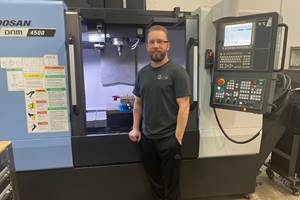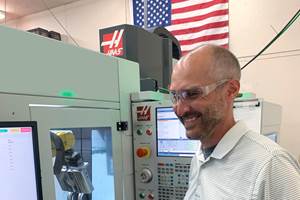Software Streamlines Mold Production
The design and manufacture of injection mold tooling for plastics connectors can be extremely complicated, with many of the forms, profiles and angles required on these small components being particularly intricate.
The Alan Group, based in Horsham, Sussex (Great Britain), comprises four companies and is acknowledged as one of Europe’s leading plastics engineering and injection molding specialists. Almost 80 percent of its production of tools and components is directly exported.
Two companies in the group are FineMoulds and Alan Grinders. The latter employs 55 people and has experience in the production of tools and molds for small electrical and electronic connectors used in computers and telephones. FineMoulds produces injection molded parts for a wide range of customers.
The design and manufacture of injection mold tooling for plastics connectors can be extremely complicated, with many of the forms, profiles and angles required on these small components being particularly intricate. Tolerances are as tight as 5 microns and the complete multi-impression tooling, which can have up to eight cavities, must be capable of consistent production of millions of parts.
Virtually all the connectors produced have pins or slots arranged to enable the physical connection to be made. This means the injection molding of such slender features, on parts as small as 12 mm by 3 mm, requires sophisticated tooling with high attention to detail, which prolonged time spent programming and machining.
However, following the recent installation of an EdgeCAM off-line programming system from Pathtrace Engineering Systems (Ontario, California) The Alan Group has been able to streamline the production of electrodes and multi-cavity molds.
EdgeCAM is used to program two vertical machining centers: Mikron WF 31 D and BostoMatic 32GS. These are used to produce a wide range of electrodes, bolster plates, inserts, cavities and various parts for gates and runner systems.
Compared with manual data input routines, through the use of macro canned cycles at the machine control, EdgeCAM already has cut programming time by up to 50 percent on complex ejector plate work, and by around a third on a number of insert plates and certain styles of electrodes. The change has reduced some 6-hour machining cycles to just 2 hours.
In addition, the software enabled the company to accept more complex tooling assignments, such as the machining of intricate pitched electrodes used for the progressive erosion of fine features. One such tool, which looks like a thick comb with offset teeth, involves machining 60 slender upstands from a solid 20 mm by 30 mm by 300 mm copper block.
Each upstand is extremely fine, being just 0.4 mm diameter, and over its 16 mm length has to be accurate to within 0.01 mm. Prior to the installation of EdgeCAM, the electrode would have been progressively built up from separate elements. Now, the entire tool can be programmed in just 60 minutes using the step and repeat area clearance routines that support islands.
The machining of complex, copper runner-electrodes on a vertical machining center also has been optimized, and it now takes around 2 hours, as opposed to 5 or 6 when the electrodes were ground using rotary wheel dressers to generate the stubby, truncated gear tooth form geometry.
By hard metal machining at spindle speeds of 16,000 rpm, small parts such as cores for mold gates can be completely roughed out prior to finish machining using the solid sink vertical EDM. This revised dual operation process is quicker and more economic than the many hours previously allowed for eroding the complete cavity.
Not only is the software used on tool and mold production—EdgeCAM also has opened other subcontract machining opportunities. Alan Grinders is attracting business now from the Formula 1 motor racing sector. In fact, it was one such motor sport component that helped convince Alan Grinders that EdgeCAM was the best programming system for the company.
Initially, Alan Grinders shortlisted four CAM systems from which two suppliers were asked to provide demonstrations. “It seemed logical to use the F1 component for the evaluation process,” says CNC programmer Glen Fowler. “This particular fuel system component had a 50-mm2 bell-shaped housing that involved machining complex 3D profiles along with quite intricate internal filets, radii and chamfers. If I manually programmed this job, it would have taken me the best part of a week.”
While both CAM systems produced a program for this job, the speed and simplicity of EdgeCAM impressed Alan Grinders. “EdgeCAM created the basic model in a little over 5 minutes and the complete program was up and ready to run within the hour,” Mr. Fowler says.
Related Content
Can ChatGPT Create Usable G-Code Programs?
Since its debut in late 2022, ChatGPT has been used in many situations, from writing stories to writing code, including G-code. But is it useful to shops? We asked a CAM expert for his thoughts.
Read MoreImproving Workflows in Small Shops with Custom ERP
Small shops might not be ready for all of the functionality of an off-the-shelf ERP system, but modular, custom ERP programs can help improve workflow while providing the flexibility to change as shops grow.
Read MoreHow to Mitigate Chatter to Boost Machining Rates
There are usually better solutions to chatter than just reducing the feed rate. Through vibration analysis, the chatter problem can be solved, enabling much higher metal removal rates, better quality and longer tool life.
Read More5 Reasons Why Machine Shop Ownership Is Changing
Mergers, acquisitions and other ownership changes are an effect of Boomer-age shop owners retiring, but only in part. Also important: The way we think about machining has changed.
Read MoreRead Next
Seeing Is Believing: 3D Vision System Enables Bin-Picking Robot
With the help of a 3D vision system and robotic arms from FANUC, MetalQuest was able to automate a physically challenging bin-picking task.
Read MoreObscure CNC Features That Can Help (or Hurt) You
You cannot begin to take advantage of an available feature if you do not know it exists. Conversely, you will not know how to avoid CNC features that may be detrimental to your process.
Read More3 Mistakes That Cause CNC Programs to Fail
Despite enhancements to manufacturing technology, there are still issues today that can cause programs to fail. These failures can cause lost time, scrapped parts, damaged machines and even injured operators.
Read More

















.png;maxWidth=300;quality=90)







